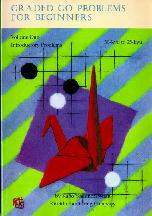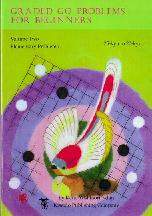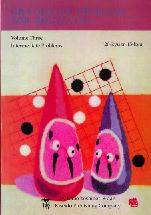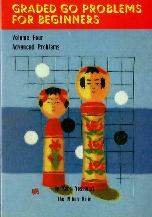Graded Go Problems For Beginners
Introduction
- Volume 1: Introductory Problems (30 kyu to 25 kyu)
- Volume 2: Elementary Problems (25 kyu to 20 kyu)
- Volume 3: Intermediate Problems (20 kyu to 15 kyu)
- Volume 4: Advanced Problems (15 kyu to 10 kyu)
Written by Kano Yoshinori and published in English by the Nihon Ki-in, first printings range from March 1985 to April 1990 and distributed by The Ishi Press. As of 2007, the series is available from Kiseido. The books cover a large range of fundamental knowledge that every player must acquire to the point that the answers to these problems become obvious upon first glance. Using GoGrinder on SGF versions of the problems is a excellent method of learning the material.
![[ext]](images/extlink.gif) Additionally, there is an interactive epub ebook version and also one for the iPad.
Additionally, there is an interactive epub ebook version and also one for the iPad.
It may be that the listed ratings for each volume are more likely to indicate that a person of that rating should know all the material in that volume as opposed to indicate the level of difficulty of the problems. Volumes 3 and 4 are often useful for single digit kyu players, for example.
The set has two drawbacks:
- a hint to solving the problem is provided in the text that accompanies each problem.
- the answers are in the back of the book rather than on the flip side of the page containing the problems.
Reviews
I was reading volume 1, and noticed how well the author introduces Go concepts to the complete beginner. For example:
- Problem 1: capture
- Problem 2: capture using the edge of board
- Problem 3: capture using a corner, capture with a stone in atari
- Problem 4: capturing multiple stones
- Problem 5: local area may have unequal numbers of stones?
- Problem 6: capturing multiple stones with a group in atari
- Problem 7: as above, but away from an edge
- Problem 8: capturing two groups at once
- Problem 9: capturing big groups
- Problem 10: capturing a big group with stone becoming atari
Contents
- Volume 1 contains 239 problems which cover several areas including recognizing atari, most basic of ladders, most basic of snapbacks, and most basic of life and death problems.
- Volume 2 contains 327 problems and an appendix about nakade and bent four in the corner.
- Volume 3 contains 421 problems, covering Opening, Middlegame, Life and Death, and Endgame problems in the first two chapters, Life and Death, Ko, Seki and Capturing Race problems in the third, with the fourth being life and death involving ko, seki, and capturing races.
- Volume 4 contains 390 problems, introducing middle game and opening problems as well as covering the same topics as volume 3 (plus a very small collection of "strange positions": Triple Ko, "long life", etc.) but with a greater emphasis on life and death.
Sample Material
(anon) 2012-07-19: Black plays, White dies? What about sacrificing two Stones?  G2?
G2?  F2!
F2!
PJT 2019-07-19: The 1985 edition does not say Black plays, White dies?. The solution shows White dead, which I presume is to show why she should sacrifice; solutions often show toughest rather than most profitable defence.
Which Volume Should I Buy?
If you are a beginner, buy the book that fits your level. If you don't have access to them in person, above are the first problems from each of the books (if the answer isn't immediately apparent, that is the book you want)
Consider buying all four, to practise doing easy problems fast at various levels.
Note: The ratings given are steep. Some of the problems in volume 1 are pretty advanced. If you think you're ready to skip ahead to volume 2 because you're 23k on IGS, read volume 1 anyway. -- Scartol
Volume 1 problems are solveable at glance by AGA 8k.
Volume 2 starting about problem 100 require reading verification of the intuitive solution -- Velobici
Volume 3 problems are solvable within 30 seconds for KGS 5k.
Volume 4 problems are challenging. There is a real gap, in terms of difficulty, between volumes 3 and 4. -- hqrpie?
You might also like to see the Problem Book Grades page for times of various ranks attempting this book. -- bucko
Trying to solve the problems without reading the hint significantly increases the difficulty of many problems. -Chaz
Questions / Solutions
This section covers questions readers have regarding specific problems.
- Volume 3, Problem 56
- Volume 4, Problem 18
- Volume 4, Problem 117
- Volume 4, Problem 334: see BQM251




![[Diagram]](diagrams/38/1e7c175fa5c82ffc38de9d98b53db0a2.png)
![[Diagram]](diagrams/42/9c61ff59a84ee5ec8195834f46a0065c.png)
![[Diagram]](diagrams/24/584321dfe13aaca150d0f8d281c52b65.png)
![[Diagram]](diagrams/4/709439c6afe124d455686e6b95cfa386.png)
![[Diagram]](diagrams/6/2cf421a3e22fb5b7f313e5ec86821804.png)
![[Diagram]](diagrams/26/72efd35ce596b8c7f402deea24ea6023.png)
![Sensei's Library [Welcome to Sensei's Library!]](images/stone-hello.png)